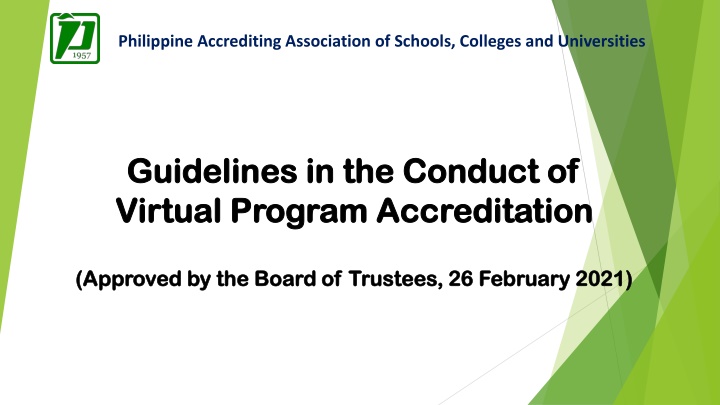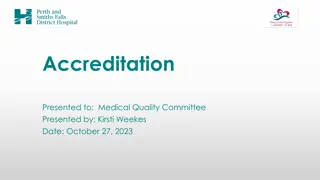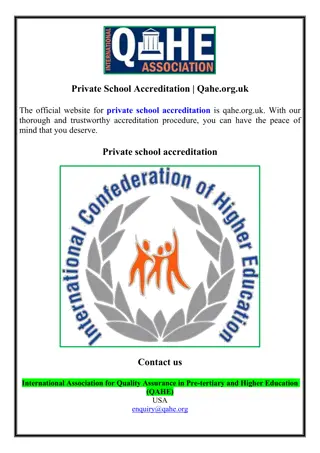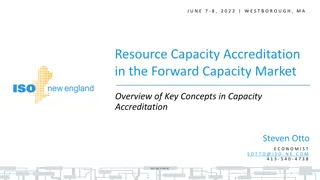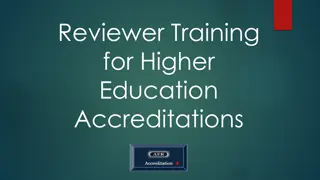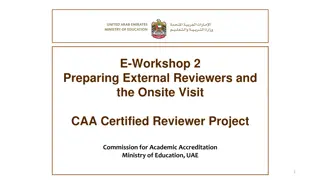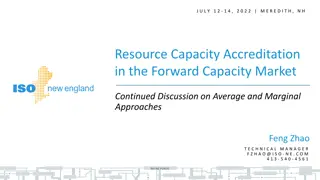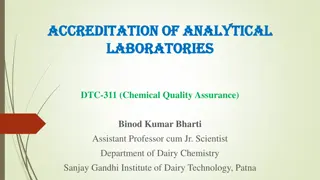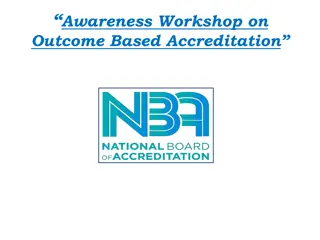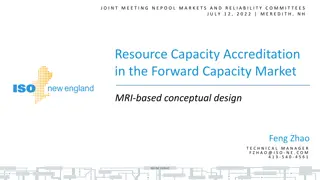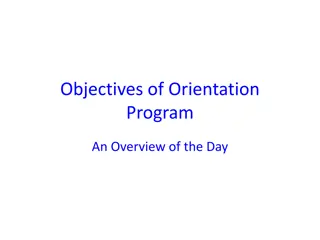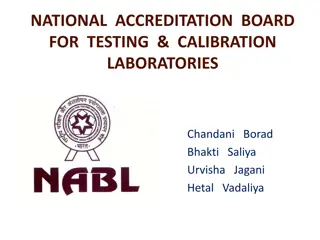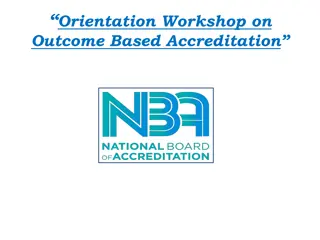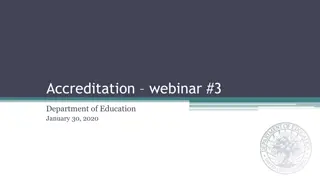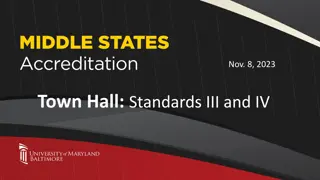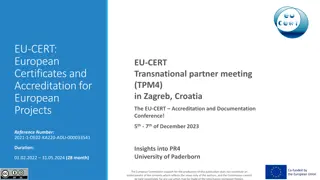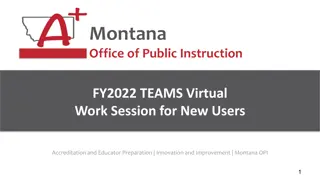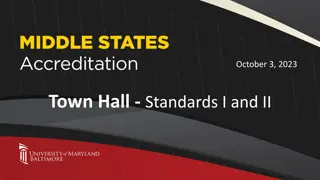Guidelines for Virtual Program Accreditation by PAASCU
PAASCU has released guidelines for conducting virtual program accreditation due to limitations on face-to-face visits. The process includes application submission, digital file storage, review by the Secretariat, self-survey by the school, and evaluation of compliance with PAASCU standards. Assistance and orientations are available for schools needing help with the application process.
Download Presentation

Please find below an Image/Link to download the presentation.
The content on the website is provided AS IS for your information and personal use only. It may not be sold, licensed, or shared on other websites without obtaining consent from the author.If you encounter any issues during the download, it is possible that the publisher has removed the file from their server.
You are allowed to download the files provided on this website for personal or commercial use, subject to the condition that they are used lawfully. All files are the property of their respective owners.
The content on the website is provided AS IS for your information and personal use only. It may not be sold, licensed, or shared on other websites without obtaining consent from the author.
E N D
Presentation Transcript
Philippine Accrediting Association of Schools, Colleges and Universities Guidelines in the Conduct of Guidelines in the Conduct of Virtual Program Accreditation Virtual Program Accreditation (Approved by the Board of Trustees, 26 February 2021) (Approved by the Board of Trustees, 26 February 2021)
Basic Assumption PAASCU will have to undertake virtual accreditation until such time that the usual mode of face-to-face accreditation visit is possible. The guidelines are grouped based on the seven (7) major steps in the accreditation process.
1. Application for Accreditation Write a letter of intent to apply, addressed to the Executive Director of PAASCU. Together with this letter are the completed documents that the school needs to submit to the PAASCU Secretariat. The documents are identified on the PAASCU website: www.paascu.org.ph.
1. Application for Accreditation Submission is done through a digital storage file, preferably Google Drive. The school will ensure that its digital capacity is sufficient to store all files it will submit. It is advised that the actual evidence is linked to the references about them for easy access. The submission, including the instructions on how to access the file, should be communicated to the Secretariat.
1. Application for Accreditation The Secretariat will review the submitted files, and if found in order, will write the school to proceed with completing the survey instrument, the soft copy of which will be emailed to the school. A list of additional requirements to supplement the survey instrument will also be given to the school (Appendix A). The review and confirmation of the school's eligibility to apply are usually completed within a month
1. Application for Accreditation If the school needs assistance on the application process, it may request an orientation from PAASCU, which will schedule the same. This will be done using the Zoom virtual meeting platform provided by PAASCU.
2. The Self-Survey A self-assessment is done by the school which usually takes at least six (6) months to complete. Members administration conduct an analysis and an evaluation of how well the school has achieved its mission-vision and objectives, and how it complies with PAASCU standards and requirements. of area committees appointed by the Stakeholder inclusion is a must in all committee groupings to ensure wider representation in the process.
2. The Self-Survey The self-assessment is documented and presented in a Self- Survey Report, which records and describes the salient features that surfaced from said analysis and evaluation. The Report is supported by institutional materials used as evidence to substantiate the institution's claims. Appendix B provides the list of exhibits usually requested from the school. All of the above should be in soft files and are made accessible online. Again, it is advised that all evidence is linked to the references about them.
2. The Self-Survey Instructions on how to access the files should be communicated to the Secretariat. These should be submitted two (2) months before the consultancy visit.
2. The Self-Survey Why the 2 months requirement? 1. give the Team sufficient time to review the report and plan the remote site visit 2. ask for additional materials from the school* 3. be familiar with the courses contained in the school s Learning Management System. *Each team member is given two (2) weeks to identify the additional materials it will ask the school to submit, forward the same to the Chairperson of the Team, who will submit a consolidated list to the Secretariat.
2. The Self-Survey The Secretariat will then forward the request for additional materials to the school, which will be given two (2) weeks to fulfill the request, download the same in the digital storage file, and inform the PAASCU Secretariat. It is to be noted that a month before the survey visit, the Self- Survey Report, and the supporting materials are deemed sufficient to undertake the visit. Appendix C shows the timeline and the related preparatory activities before the visit.
3.The Consultancy Visit A school applying for a Preliminary Survey is not placed on the visit-ready list until PAASCU, through the relevant Commission, has assigned a consultant. The consultant will: guide the Preliminary Visit preparations, including any improvement in the submitted Self-Survey Report and supporting materials. determine the school's readiness and inform PAASCU of the school's earliest time to undertake the visit. A school can request a Consultant after it has completed its self-survey.
3.The Consultancy Visit The consultancy will be done virtually. Flexibility is encouraged in the conduct of the consultancy visit, including the scheduling of meetings and the communication channels to be used. The school and the consultant will agree on the agenda and this should be communicated by the consultant to the Secretariat.
4. The Preliminary Visit A Survey Team will conduct the remote site visit using the Zoom platform that PAASCU will provide. The Team takes a general look at the school s situation, validates the Self-Survey Report through interviews and examination of evidence, studies the recommendations presented in the Self- Survey Report, cites best features of the different areas, and makes recommendations of its own where necessary. Once the program is judged ready for a Formal Survey Visit, it is granted "Candidate" status for a two (2)-year period.
4. The Preliminary Visit It is suggested that all meetings during the two (2) day visit will be conducted in plenary. There may be instances; however, that the Team will decide to schedule concurrent meetings. A 10 or 15-minute private discussion of the team will follow each meeting to: highlight key points discussed and plan for the succeeding meeting to allow the new set of interviewees to enter the virtual meeting room.
4. The Preliminary Visit Synchronous classes will be observed virtually, and a virtual tour of key facilities will also be conducted. The agenda for the 2-day visit will be finalized by the Team and submitted to the Secretariat. The Secretariat will then forward these to the school one (1) month before the accreditation visit. Appendices D and E show the proposed schedule of the 2-day visit for Basic Education and Higher Education programs, respectively.
4. The Preliminary Visit The school will submit to the Secretariat two (2) weeks before the visit the completed template for the list of interviewees and the plan for the live walk-through tour if any. Appendix F shows the template for the list of interviewees.
4. The Preliminary Visit The following have to be undertaken to facilitate the conduct of the visit: 1. Ensure that there is stable internet connectivity during the visit. 2. Zoom Meetings access information from PAASCU will be given to the school two (2) weeks before the visit. Appendix G provides the technical specification and guidelines for the use of the Zoom meeting platform.
4. The Preliminary Visit 3. The technology should be tested in advance, at least one (1) week before the school visit with all the following people present: the Team members including the PAASCU Representative and a PAASCU Technical Staff, the school representatives, particularly the person who manages the preparations for the visit and the Technical Staff. An agreed-upon contingency plan should be crafted in the event of technology failure.
4. The Preliminary Visit 4. For the observation of synchronous classes, the school will provide the Team two (2) weeks before the visit access to the meeting platform for such classes. Appendices H and I shows the classroom observation forms to be used by the Team for Basic Education and Higher Education, respectively.
4. The Preliminary Visit 5. A virtual tour of the facilities will be done either: as pre-recorded tour in video format which will be submitted as part of the materials to support the Self-Survey Report; or (and) A live walk-through tour during the remote visit to supplement the pre-recorded tour.
4. The Preliminary Visit 6. The school's IT personnel should be available for the visit's duration 7. The school s key personnel assigned to manage the accreditation visit should be accessible during the two (2) day visit 8. The PAASCU representative and a PAASCU technical staff will also be available to provide support
5. The Formal Survey Visit Before a formal survey visit is undertaken, the school must undertake another self-assesssment activity using the self- survey instrument, the supplement, and the Team's Survey Report that did the Preliminary Visit. The school will undertake the same process undertaken during the Preliminary Visit with the additional task of stating the status of actions taken on the recommendations written on the Team s Survey Report. All of these will be documented in the Self-Survey Report and the supporting materials.
5. The Formal Survey Visit The Formal Survey Visit is conducted by a Team one (1) year after the Preliminary Visit. The visit follows the same process conducted during the Preliminary Visit. The Team, however, now cites the action taken by the school on the recommendations given by the Preliminary Survey Team and provides numerical ratings for each area under survey.
6. Initial Accreditation Status Granted Upon favorable evaluation and recommendation by the Team and the relevant PAASCU Commission, the PAASCU Board of Trustees grants initial accreditation, which FAAP certifies with Level I status, for three (3) years. With this initial accreditation, the school becomes a full member of PAASCU.
7. Full Accreditation Status Granted After the three (3)-year period, the program undertakes another self-survey and is visited by the Team. A favorable re-evaluation merits the program's full accreditation for five (5) years. The program is also granted FAAP Level II re- accredited status at this time. Levels III and IV status will be granted in the future following the existing FAAP Guidelines. The process and guidelines for the self-survey and the remote site visit will be the same as in the Formal Survey Visit.
Special Visits Interim Visit is done when there are major deficiencies in certain areas under accreditation during the previous re- survey visit. Although done for only one (1) day, the process and guidelines in this visit will follow that of a Re- survey visit. Revisit, which is done when accreditation is deferred on the previous accreditation visit. The process and guidelines in this visit will follow that of a Formal or a Re- survey visit.
Others Appendix J shows a comparative matrix of processes under face-to-face and virtual program accreditation. Appendix K shows the socialized accreditation fees charged to the school for the virtual program accreditation visit. Please note that the fees will only be collected when doing a remote site visit. Depending on the situation, particularly government regulations on the conduct of face-to-face classes and travel restrictions, and accreditors' availability, a blended approach can also be adopted. The process for this blended approach will have to be agreed upon by the school and PAASCU.
